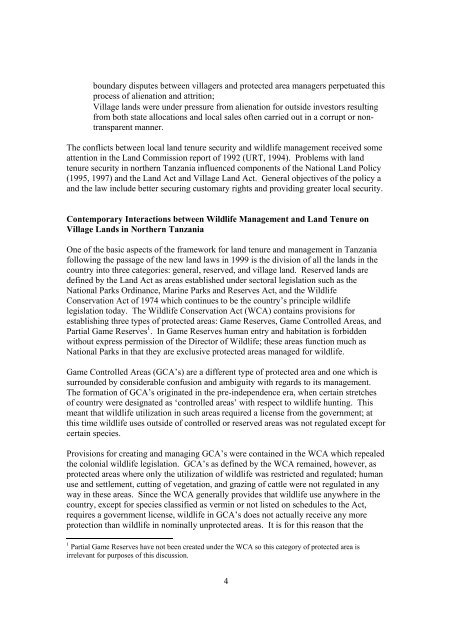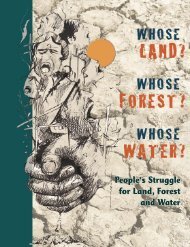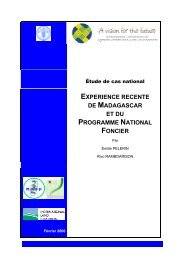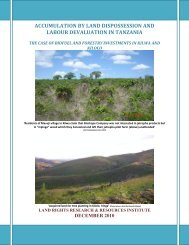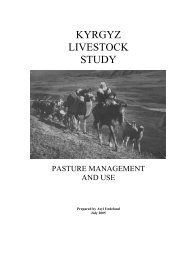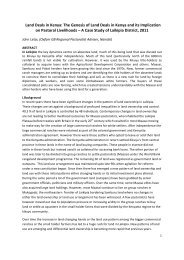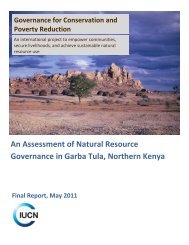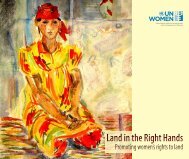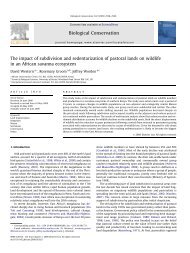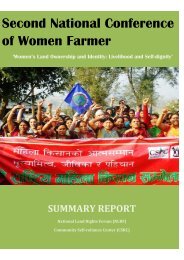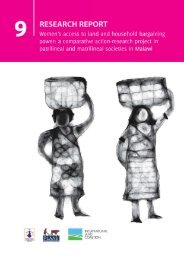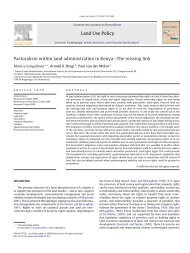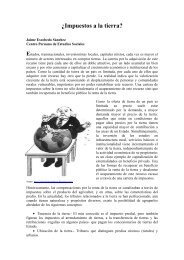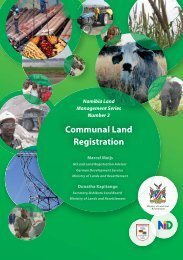Wildlife Management and Village Land Tenure in ... - Land Portal
Wildlife Management and Village Land Tenure in ... - Land Portal
Wildlife Management and Village Land Tenure in ... - Land Portal
Create successful ePaper yourself
Turn your PDF publications into a flip-book with our unique Google optimized e-Paper software.
oundary disputes between villagers <strong>and</strong> protected area managers perpetuated this<br />
process of alienation <strong>and</strong> attrition;<br />
<strong>Village</strong> l<strong>and</strong>s were under pressure from alienation for outside <strong>in</strong>vestors result<strong>in</strong>g<br />
from both state allocations <strong>and</strong> local sales often carried out <strong>in</strong> a corrupt or nontransparent<br />
manner.<br />
The conflicts between local l<strong>and</strong> tenure security <strong>and</strong> wildlife management received some<br />
attention <strong>in</strong> the L<strong>and</strong> Commission report of 1992 (URT, 1994). Problems with l<strong>and</strong><br />
tenure security <strong>in</strong> northern Tanzania <strong>in</strong>fluenced components of the National L<strong>and</strong> Policy<br />
(1995, 1997) <strong>and</strong> the L<strong>and</strong> Act <strong>and</strong> <strong>Village</strong> L<strong>and</strong> Act. General objectives of the policy a<br />
<strong>and</strong> the law <strong>in</strong>clude better secur<strong>in</strong>g customary rights <strong>and</strong> provid<strong>in</strong>g greater local security.<br />
Contemporary Interactions between <strong>Wildlife</strong> <strong>Management</strong> <strong>and</strong> L<strong>and</strong> <strong>Tenure</strong> on<br />
<strong>Village</strong> L<strong>and</strong>s <strong>in</strong> Northern Tanzania<br />
One of the basic aspects of the framework for l<strong>and</strong> tenure <strong>and</strong> management <strong>in</strong> Tanzania<br />
follow<strong>in</strong>g the passage of the new l<strong>and</strong> laws <strong>in</strong> 1999 is the division of all the l<strong>and</strong>s <strong>in</strong> the<br />
country <strong>in</strong>to three categories: general, reserved, <strong>and</strong> village l<strong>and</strong>. Reserved l<strong>and</strong>s are<br />
def<strong>in</strong>ed by the L<strong>and</strong> Act as areas established under sectoral legislation such as the<br />
National Parks Ord<strong>in</strong>ance, Mar<strong>in</strong>e Parks <strong>and</strong> Reserves Act, <strong>and</strong> the <strong>Wildlife</strong><br />
Conservation Act of 1974 which cont<strong>in</strong>ues to be the country’s pr<strong>in</strong>ciple wildlife<br />
legislation today. The <strong>Wildlife</strong> Conservation Act (WCA) conta<strong>in</strong>s provisions for<br />
establish<strong>in</strong>g three types of protected areas: Game Reserves, Game Controlled Areas, <strong>and</strong><br />
Partial Game Reserves 1 . In Game Reserves human entry <strong>and</strong> habitation is forbidden<br />
without express permission of the Director of <strong>Wildlife</strong>; these areas function much as<br />
National Parks <strong>in</strong> that they are exclusive protected areas managed for wildlife.<br />
Game Controlled Areas (GCA’s) are a different type of protected area <strong>and</strong> one which is<br />
surrounded by considerable confusion <strong>and</strong> ambiguity with regards to its management.<br />
The formation of GCA’s orig<strong>in</strong>ated <strong>in</strong> the pre-<strong>in</strong>dependence era, when certa<strong>in</strong> stretches<br />
of country were designated as ‘controlled areas’ with respect to wildlife hunt<strong>in</strong>g. This<br />
meant that wildlife utilization <strong>in</strong> such areas required a license from the government; at<br />
this time wildlife uses outside of controlled or reserved areas was not regulated except for<br />
certa<strong>in</strong> species.<br />
Provisions for creat<strong>in</strong>g <strong>and</strong> manag<strong>in</strong>g GCA’s were conta<strong>in</strong>ed <strong>in</strong> the WCA which repealed<br />
the colonial wildlife legislation. GCA’s as def<strong>in</strong>ed by the WCA rema<strong>in</strong>ed, however, as<br />
protected areas where only the utilization of wildlife was restricted <strong>and</strong> regulated; human<br />
use <strong>and</strong> settlement, cutt<strong>in</strong>g of vegetation, <strong>and</strong> graz<strong>in</strong>g of cattle were not regulated <strong>in</strong> any<br />
way <strong>in</strong> these areas. S<strong>in</strong>ce the WCA generally provides that wildlife use anywhere <strong>in</strong> the<br />
country, except for species classified as verm<strong>in</strong> or not listed on schedules to the Act,<br />
requires a government license, wildlife <strong>in</strong> GCA’s does not actually receive any more<br />
protection than wildlife <strong>in</strong> nom<strong>in</strong>ally unprotected areas. It is for this reason that the<br />
1 Partial Game Reserves have not been created under the WCA so this category of protected area is<br />
irrelevant for purposes of this discussion.<br />
4


